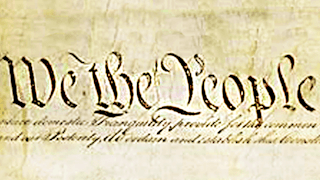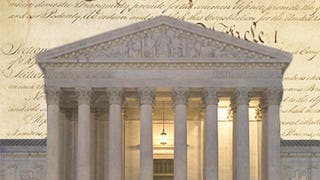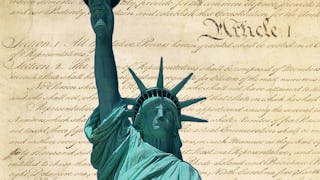An introduction to basic techniques of constitutional interpretation.



(271 reviews)
Details to know

Add to your LinkedIn profile
3 assignments
See how employees at top companies are mastering in-demand skills


Earn a career certificate
Add this credential to your LinkedIn profile, resume, or CV
Share it on social media and in your performance review

There are 15 modules in this course
Hello everyone and welcome to America’s Unwritten Constitution! This course is designed to teach you some of the basic tool and techniques for constitutional interpretation. Over the next 13 modules, Professor Akhil Amar will teach you how to go beyond the text of the U.S. Constitution, while still remaining faithful to it. Please, take some time to watch the two introductory videos and read through some of the course information below. Enjoy!
What's included
2 videos7 readings
Heeding the Deed, refers to the technique of understanding the Constitution further by looking at issues the nation was dealing with at the time of the passage's adoption. Another way to say this could be; putting yourself in the framer's shoes.
What's included
2 videos
This module teaches the interpretive technique of reading between the lines. This involves extracting, from the text, things that are implicit, but not expressly stated.
What's included
2 videos
In this module, we explore a number of unenumerated rights that exist simply because Americans embody these rights in their everyday lives. Owning pets, using contraception, testifying at one’s own trial, none of these are explicitly mentioned in the text of the Constitution, yet today, they are recognized as protected fundamental rights. Professor Amar explains why.
What's included
2 videos
The "Confronting Modern Case Law" lectures take a closer look at the Warren-lead Supreme Court. Spanning from 1953 to 1969, his court decided many of the most influential cases is U.S. history. Brown v. Board of Education, Miranda v. Arizona, Griswold v. Connecticut to name a few. Professor Amar, will discuss how the court arrived at their decisions, how these rulings changed American society at the time and how they are still affecting it today.
What's included
2 videos1 assignment
Professor Amar discusses the role that precedent—that is, prior court decisions—plays in our understanding of the document. He will answer questions about how far courts should go when interpreting the Constitution, and what courts might do when they believe that a prior decision was incorrect.
What's included
2 videos
Here we'll examine documents outside of the Constitution that influence our understanding of the founding text—things like the Declaration of Independence, The Federalist papers, Lincoln’s Gettysburg Address, and Martin Luther King’s I Have a Dream speech. Professor Amar will explain how these sources have offered meaning and guidance in constitutional interpretation.
What's included
2 videos1 peer review
These lectures explore the profound changes American society underwent immediately following the ratification of the 19th amendment. The reverberations of women's enfranchisement are still being strongly felt today. Prof. Amar will highlight some legislation, he believes, directly or indirectly owe their existence to the 19th amendment.
What's included
2 videos
Undoubtedly, the figure who looms largest in U.S. political history is George Washington. His actions before, during, and after the Presidency set precedents for the executive office which are still observed today. Prof. Amar will explain why Article II of the Constitution was custom written for our first president.
What's included
2 videos1 assignment
This module delves into how the actual structure of each government branch inherently effects their interactions with one another. The framers purposefully under-specified sections of the Constitution, leaving room for flexibility. They rightly assumed future law makers would fill these “gaps” in procedure as need arose. Indeed they have, each time a gap is discovered and bridged, a new precedent is set. Professor Amar will highlight several examples of these powers-set-by-precendent, for each branch of government
What's included
2 videos
In this module, Prof. Amar chronicles the adoption and evolution of the two party system in America. You'll learn which framers founded each party and how the creation of the parties caused great friction in government. The lectures go on to explain how the Constitution changed to accommodate the two party system and how these changes have made to the two party system inextricably codified into the Document.
What's included
2 videos1 peer review
This module discusses the role of conscience in government. It is important for us to remember, the Constitution did not implement itself. It was implemented by human beings with minds, hearts, and consciences. Understanding the interaction between these “human elements” and the text is fundamental to proper interpretation of the Constitution. We’ll go over several codified manifestations of the "human element" in the Constitution, such as the veto and juror nullification.
What's included
2 videos
In the course’s final lectures, we’ll look to the future and ask, "what will the constitution look like in 25 years? 50 years? 100?" Might we soon see an amendment allowing for a foreign born president? Or the dissolution of the Electoral College? Prof. Amar will discuss the idea of "constitutional trajectory," and the factors which affect it. We’ll go over how today’s legislators can be looked at as "framers of the future.” Which will lead to the very interesting topic of “sunrise legislation."
What's included
2 videos1 assignment
This content is not tied to the assessment materials in any way but it is interesting, entertaining, and informative nonetheless. We encourage all learners to take some time to watch these videos and post about them in the discussion forums!
What's included
5 videos
Prof. Amar recapitulate concepts learned in this course and discuss his hopes for you all; the matriculants of America’s Unwritten Constitution. We sincerely hope you all have enjoyed the course and learned something along the way! Thank you so much for your time and effort.
What's included
1 video
Instructor

Offered by
Explore more from Law


Yale University


University of Pennsylvania


University of California, Irvine


University of California, Irvine
Why people choose Coursera for their career




Learner reviews
271 reviews
- 5 stars
88.60%
- 4 stars
6.61%
- 3 stars
2.57%
- 2 stars
1.47%
- 1 star
0.73%
Showing 3 of 271
Reviewed on Mar 28, 2017
Great course! The professor is unstructured, and has the tendency to ramble in the lecture, but thoroughly enjoyed the course.
Reviewed on Nov 13, 2020
An exceptional explication of America's Constitution beyond the written words.
Reviewed on Mar 2, 2021
I loved this course, and the predecessor, America's Written Constitution. I'd like to see more Constitutional Law courses offered.

Open new doors with Coursera Plus
Unlimited access to 10,000+ world-class courses, hands-on projects, and job-ready certificate programs - all included in your subscription
Advance your career with an online degree
Earn a degree from world-class universities - 100% online
Join over 3,400 global companies that choose Coursera for Business
Upskill your employees to excel in the digital economy
Frequently asked questions
Access to lectures and assignments depends on your type of enrollment. If you take a course in audit mode, you will be able to see most course materials for free. To access graded assignments and to earn a Certificate, you will need to purchase the Certificate experience, during or after your audit. If you don't see the audit option:
The course may not offer an audit option. You can try a Free Trial instead, or apply for Financial Aid.
The course may offer 'Full Course, No Certificate' instead. This option lets you see all course materials, submit required assessments, and get a final grade. This also means that you will not be able to purchase a Certificate experience.
When you purchase a Certificate you get access to all course materials, including graded assignments. Upon completing the course, your electronic Certificate will be added to your Accomplishments page - from there, you can print your Certificate or add it to your LinkedIn profile. If you only want to read and view the course content, you can audit the course for free.
You will be eligible for a full refund until two weeks after your payment date, or (for courses that have just launched) until two weeks after the first session of the course begins, whichever is later. You cannot receive a refund once you’ve earned a Course Certificate, even if you complete the course within the two-week refund period. See our full refund policy.
More questions
Financial aid available,


